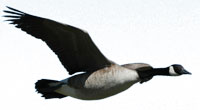|
Coordinated Management
The Pacific Flyway Council is an administrative
body that forges cooperation among public wildlife agencies for the
purpose of protecting and conserving migratory birds that inhabit
western North America. The Council is composed of the director or an
appointee from the public wildlife agency in each state and province
in the western United States, Canada, and Mexico.
Migratory birds use four major migratory routes (Pacific, Central,
Mississippi, and Atlantic flyways) in North America. Because of the unique
biological characteristics and relative number of hunters in these regions,
state and federal wildlife agencies adopted the flyway structure for
administering migratory bird resources within the United States. Each
flyway has its own council.
Flyway councils have responsibilities in the annual process of setting
migratory bird policy and regulations within the United States and conduct
and contribute to migratory bird research and management throughout the
United States, Canada, and Mexico.
The Pacific Flyway Council has both a game and nongame migratory bird
technical committee that provides biological advice to the council. The
technical committees are each composed of one biologist from the public
wildlife agency in each state and province in the western United States,
Canada, and Mexico.
In the U.S., the Pacific Flyway includes Alaska, Arizona, California,
Idaho, Nevada, Oregon, Utah, Washington, and those portions of Colorado,
Montana, New Mexico, and Wyoming west of the Continental Divide.
Alaska is the only state where migratory bird and egg hunting is allowed
in spring and summer in certain rural areas for
subsistence needs. The Council works with the
Alaska Migratory Bird
Co-management Council to develop migratory bird hunting regulations and
coordinate management of migratory birds.

|



